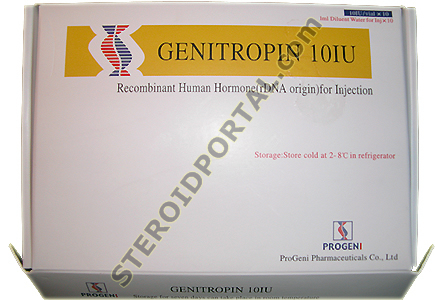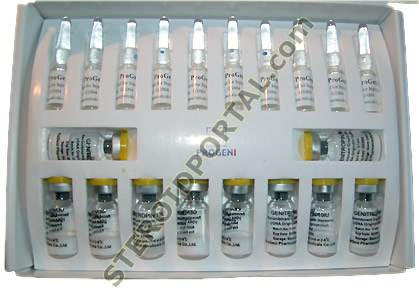Genitropin HGH 10iu description, Genitropin HGH 10iu side effects, Genitropin HGH 10iu price, Genitropin HGH 10iu substance
 |
 |
![]() The use of exogenous sources of Growth Hormone has been popular in the United States for almost 8 years now. Originally, athletes used biologically active forms that were the actual extract of the pituitary glands of cadavers. Ascellacrin and Crescormon were the two most popular brand names on this original GH. While production was under way on the synthetic, recombinant DNA versions of this drug, it was discovered that the biologically active form was associated with the formation of a rare brain virus called Creutzveldt Jacob Disease. This was a fatal virus that afflicted a very small number of GH users, none of whom were athletes. In light of this discovery, the FDA removed all of these natural GH versions from the market in the United States.
The use of exogenous sources of Growth Hormone has been popular in the United States for almost 8 years now. Originally, athletes used biologically active forms that were the actual extract of the pituitary glands of cadavers. Ascellacrin and Crescormon were the two most popular brand names on this original GH. While production was under way on the synthetic, recombinant DNA versions of this drug, it was discovered that the biologically active form was associated with the formation of a rare brain virus called Creutzveldt Jacob Disease. This was a fatal virus that afflicted a very small number of GH users, none of whom were athletes. In light of this discovery, the FDA removed all of these natural GH versions from the market in the United States.
Luckily, the synthetic recombinant versions were approved by the FDA a short time afterwards. These versions were developed after years of experiments with amino acid chains. The first of these versions was patented and produced by Genentech Labs with the brand name Protropin. A short time later, another form of synthetic Growth Hormone gained FDA approval. It was produced by Eli Lilly Labs and brand named Humatrope.
This product was allowed to be patented because it was shown to be unique in that it contained a slightly different amino acid chain than the Protropin. The difference was that Humatrope had 191 amino acid chains in sequence and Protropin had 192. For some very complicated reasons, the 191 amino acid configuration has been shown to be more effective. It had been speculated that these synthetic versions of GH would greatly improve the cost effectiveness of using GH, yet that has not been the case. An athlete who wants to do a cycle of GH can still expect to be out as much as $4000 a month. There are numerous versions of Growth Hormone available in Europe, the majority of which are made up of the 191 amino acid sequence. There is even a form of the original human extract Growth Hormone, called Grorm which is available in a few countries. Although this drug is indicated for the treatment of pituitary deficient dwarfism, it has been used extensively by athletes who are attempting to alter their body compositio.Growth Hormone itself, is an endogenous hormone produced by the pituitary gland. It exists at especially high levels during the teen years when it promotes growth of almost all tissues. It also contributes to the deposition of protein and promotes the breakdown of fat for use as energy.
As the body reaches full maturation, the endogenous levels of GH are substantially diminished. After this, GH is still present in the body but at a substantially lower level where it continues to aid in protein synthesis, RNA and DNA reactions and the conversion of body fat to energy. By introducing an exogenous source of this hormone, athletes are hoping to promote these effects, causing the body to deposit more muscle tissue while at the same time reducing body fat stores. On paper, GH should work exceptionally well; however, it does not seem to be delivering up to its potential. Most athletes who have experimented with this product end up being disappointed. There is some evidence that exogenous sources of GH are being destroyed by antibodies which appear after the introduction of the synthetic compound. Although the 191 amino acid sequence versions have been shown to produce less of an antibody reaction, they are still not yielding consistent results. I have speculated as to whether the introduction of exogenous GH would yield an appreciable degree of efficacy simply due to the fact that the body does not have sufficient receptor affinity to GH in the post-teen years.
A number of athletes claim that GH is not that effective on its own, but in a stack with steroids it can do remarkable things. Perhaps there is some type of actual synergism created by the concomitant use of these two agents. Empirical data suggests that the efficacy of GH is dose related and that the majority of users may not have been taking enough of it to get positive results. Despite speculation concerning its efficacy, synthetic GH is being used by thousands of elite athletes. These include men and women bodybuilders, strength athletes, as well as a multitude of Olympic competitors. Although Growth Hormone is banned by athletic committees, there is no method for the detection of it which allows drug tested competitors to use this product freely without any ramifications. Adverse reactions to GH use are rare but technically could involve acromegaly (elongation of the feet, forehead and hands). Other possible side effects involve overgrowth of the elbows or jaw, thickening of the skin and a type of diabetes. There are numerous counterfeit versions of this product which are merely cashing in on the drug's mystique and high price tag. The legitimate versions must be refrigerated at all times, before and after they are reconstituted. Effective dosages seem to be in the area of 2 I.U., 2-4 times a week. Cycle length is usually determined by how long the athlete can afford it. Some take the product for 6 week cycles, others use it year round.
Package: 1 amp - 10i.u.
Effective Dose: 2-4 I.U., 2-4 times a week
Human Growth Hormone
Description Genitropin HGH 10iu:
Human growth hormone, as prepared for medical use. This is currently the most expensive drug in use by athletes, so one should take special care when acquiring this on the black market. A high percentage of these items turn out to be relabeled HCG which bears a resemblance to GH. Some more unsterile and dangerous counterfeits have also been reported. Growth hormone itself is very delicate and is best stored at cool temperatures and used quickly. This is added worry, even when purchasing legitimate GH, as the item may not have been handled properly before purchase.
Human growth hormone (hGH) is produced by somatotropes in the pituitary gland of the human brain. Somatotropes make up more than 50% of the pituitary gland and growth hormone is by far the most important hormone produced there. By the age of 60 most people will have approximately 80% less growth hormone in their system than when they were 20. Signs of GH reduction include increased body fat, increased anxiety, social isolation, poor general health, and lack of positive well being. GH has been the supplement of choice for many professional athletes over the years. American football great, Lyle Alzado, claimed that 80% of all professional American football players, including himself, have taken GH. GH has amazing age-reversing effects that make it possibly the strongest anabolic substance available. Some of the benefits associated with GH supplementation include the reversal of common diseases associated with aging, improved brain activity and function, it strengthens connective tissue which reduces the probability of injury, incredible weight loss without any loss in lean mass, reduces wrinkles by rejuvenating the skin, it raises energy levels and brightens mood, promotes muscle growth, improves libido, improves functions of the lungs which increases the level of oxygen in the blood stream, provides immune system support and Thymus function, and probably the most impressive characteristic is, its ability to produce more muscle cells, something no steroid can do.
There has been a lot of controversy around GH and its effectiveness. While one athlete may make tremendous strides toward his goal, another may see practically no improvement at all. This is easily explained. Because GH is dosage-dependent, often times an athlete doesn't use enough, long enough. A sufficient dose of GH can cost around $150-$170 per day and a common black market price is around $20-$30 per I.U. making GH possibly the most expensive supplement. Another misconception is that GH by itself is the answer. GH by itself is practically useless. The real problem isn't a lack of GH secretion but a lack of GH conversion in the liver. There are two other hormones that are needed for maximum anabolic effect; insulin, and Cytomel or other LT-3 thyroid hormone. This can be further enhanced by the supplementation of other anticatabolic drugs such as steroids, Clenbuterol, or an ephedrine based supplement.
It is tough to find out what the most effective dosages are. According to our sources, it is popular to use about .3 I.U./week for each pound of body weight. For example a person weighing 200lbs. will need 60 I.U. per week. The dosages can be injected intramuscularly three times a week broken into 20 I.U. injections. A more popular way to inject is subcutaneously (under the skin and above the muscle) using 1/2" insulin needles. When injected this way the dosage should be done daily in small intervals alternating to each side of the body with each injection. American doctors often prescribe a dosage of 2 I.U. per day, however a popular dosage is between 4-10 I.U. a day. When injecting GH, it is important to not inject in the same area every time.
Side effects of GH are not at all the same as with anabolic and androgenic steroids. Most common side effects are hypoglycemia (low blood sugar level) and inadequate thyroid function. A huge misconception, brought on by the mass media, is that Giantism is a common side effect of using GH in the normal human body. This is only true if GH is used during the pre-pubescent period time in ones life. It is very important that a person be completely full grown and mature before using GH. Other rare side effects include diabetes, heart enlargement, high blood pressure, and enlargement of the kidneys. The most common problem is not with the injecting of GH, but the injecting of the insulin to go with it. Improper injection of insulin can lead to serious problems.
Growth Hormone comes from the substance somatotropin which is available in a powder form as well. It must be mixed with the solution that it comes with before it can be injected. It is suggested that the solution be injected immediately or stored in the refrigerator.

People Also Search For:
